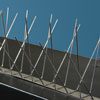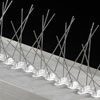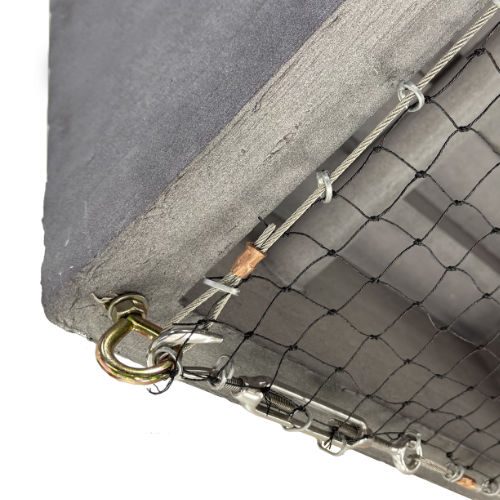Pigeon Control: How To Get Rid Of Pigeons
Getting rid of pigeons on your own isn’t easy. These pest birds have an inbred homing instinct that makes them feel attached to their established roosting and nesting sites. Plus, mating pairs can hatch as many as four broods a year, so a small pigeon problem can quickly turn into a disaster.
Pigeons will resort to laying eggs on bare surfaces if need be, so getting rid of pigeons isn’t as simple as removing their nests. Fortunately, Bird Barrier offers a number of high-quality pigeon control products that can effectively resolve any type of pigeon problem.

Problems Caused by Pigeons Sitting and Nesting
Pigeons are the most common type of pest bird in North America and they cause a variety of problems at all kinds of buildings, from airports to manufacturing facilities to power plants and the rooftops of stores, offices, and homes. Because pigeon droppings contain uric acid, which is highly corrosive, pigeons can cause a great deal of damage in a short amount of time. Feral pigeons are responsible for untold millions of dollars of damage each year in urban areas. Here are a few of the other most common pigeon roosting problems (and reasons why people need effective pigeon deterrents):
- Pigeons (and pigeon waste) can hurt the image of a business or commercial enterprise as they leave a bad impression
- Collected debris from roosting pigeon flocks can cause water damage by blocking up gutters and drains
- Roosting pigeons often cause extensive damage to air conditioning units and other rooftop machinery
- Droppings create hazardous surfaces that lead to slip and fall liability
- Bacteria, fungal agents, and ectoparasites found in pigeon droppings can pose a health risk.
Tell us about your pigeon problem and we’ll point you to the solutions you need. Click the Ask an Expert button to the right.
Pigeon Control Solutions: Pigeon Spikes, Netting, Birth Control and More
Because pigeon prevention can be easier than pigeon removal, we at Bird Barrier always recommend proactive use of deterrent products that will cause these birds to roost elsewhere, so their homing instinct isn’t bringing them back to your property!
If you already have a flock of pigeons on your property, the first line of defense, as with all pest birds, is removing all sources of food and water from the site. However, you will need to take additional steps to control an established pigeon problem. Bird Barrier offers a number of solutions to deter and repel pigeons, from pigeon spikes to exclusion netting to birth control and beyond. With the right pigeon control products, you can solve any pigeon problem for good.
How to Select the Right Pigeon Deterrents For Any Situation
The most effective approaches to pigeon control and prevention include:
- Exclusion Netting
- Electric Shock
- Spikes, Optical Gel, Coil
- Pigeon Reproductive Control
- Audio, Visual, and Taste Deterrents
Recommended Products


Economical bird spike made from 100% stainless steel. Perfect for Pigeons or larger.






To determine how to best solve your specific pigeon problem, we must first know the answer to two questions:
1. What is the bird pressure at the site?
- Heavy: pigeons are nesting, extremely committed to the site
- Medium: pigeons are eating nearby, really like this site
- Light: pigeons are hanging out here from time to time, not really committed
2. What structures are the pigeons sitting on?
- Roof peak
- Narrow ledge
- Wide ledge
- Pipe
- Flat surface
- Signs
- Protected nook
- Underside of loading dock roof, on pipes and beams
Create a Pigeon Control System for Your Specific Site and Problem
Use the following guidelines to help you determine which pigeon control products and pigeon repellent devices might be best for the challenge you are trying to solve.
Pigeons Roosting on Roof Peaks
- Medium pressure: Bird-Shock Flex-Track (trains pigeons by giving them an electric shock when they land)
- Medium pressure: Bird Spikes » Bird-Flite or Dura-Spike (humane spikes prevent pigeons from landing on surfaces)
- Medium pressure: Bird Barrier Optical Gel (a visual bird repellent that deters pigeons by tricking them into seeing fire or smoke, although there isn’t any and they smell peppermint oil, which they hate)
Pigeons Roosting or Nesting on Narrow Ledges (less than 6 in.)
- Heavy pressure: BirdSlide (prevents pigeons from getting a grip so they slide right off the ledge)
- Heavy pressure: Bird-Shock Flex-Track
- Medium or light pressure: Bird Barrier Optical Gel
- Medium or light pressure: Bird Spikes » Bird-Flite or Dura-Spike
Pigeons Roosting or Nesting on Wide Ledges (more than 6 in.)
- Heavy pressure: StealthNet (exclusion netting made of polyethylene twine. Keeps pigeons out! In many situations, the best solution for pigeon problems is complete exclusion with a 2″ mesh StealthNet)
- Heavy pressure: BirdSlide
- Medium or light pressure: Bird Barrier Optical Gel
- Medium or light pressure: Bird Spikes » Bird-Flite or Dura-Spike
Pigeons Roosting on Pipes
- All pressures: Birdwire with Railing Clamps
- All pressures: Bird Spikes » Bird-Flite or Dura-Spike
Pigeons Roosting on Flat Surfaces
- Large area – medium or light pressure: Daddi Long Legs (waving rods with plastic tips deter pigeons from landing on hard-to-protect areas)
- Large area – medium or light pressure: Eagle Eye (visual pigeon deterrent that works by scaring and disorienting them with reflected sunlight)
- Large area – medium or light pressure: StealthNet (pigeon exclusion when placed over over rooftop)
- Smaller area – medium or light pressure: Bird Barrier Optical Gel
Pigeons Roosting or Nesting On Signs
- Heavy pressure: StealthNet
- Medium or Light pressure: Bird Barrier Optical Gel
- Medium or Light pressure: Bird-Shock Flex-Track
Pigeons Roosting or Nesting in Protected Nooks
- All pressures: StealthNet
Pigeons Roosting or Nesting on the Underside of Loading Docks and on Pipes and Beams
- All pressures: StealthNet
- Medium to light pressure: Bird Barrier Optical Gel
Pigeons Roosting on Long Exposed Ledges, Parapets, Signs, Beams, and Pipes:
- Medium to light pressure: Bird Barrier’s Bird-Coil provides an effective deterrent against pigeons that consists of loops of coiled stainless steel that makes it difficult for pigeons to land).
- Medium to light pressure: Bird-Wire is stainless steel nylon coated wire attached to stainless steel posts and tensioned using springs. Bird-Wire repels pigeons from long exposed ledges, parapets, signs, beams, and pipes.
At Bird Barrier, we’re here to help you find exactly what you need for your situation—whether that’s a large facility, a commercial building, or your home. We offer expert support with our Product Advisor tool, installation videos, and top-of-the-line customer service.
A Humane, Effective Solution: Pigeon Spikes
Got problems with pigeons roosting on signs, gutters, rooftops, ledges, beams, pipes, chimneys, window sills, and other structures? Pigeon spikes are the answer! Our Dura-Spike™, Bird-Flite®, and Gutter-Point™ bird spikes are three highly effective pigeon repellent options that are practically invisible from a distance.
Bird spikes prevent pigeons from gaining a foothold when they try to land. Instead of roosting on your property, they give up and fly away. The tips of the pigeon spikes are not sharpened so they will not cause injuries to birds or installers!
Pigeon spikes work best in situations of medium or light bird pressure–they are not recommended for removing pigeons from established night roosts or nesting sites. Another Bird Barrier product, like StealthNet or BirdSlide will provide better protection in those situations.
Pigeon Birth Control: One of the Best Pigeon Deterrents for Large Properties
OvoControl P is a ready-to-use bait that controls the reproduction of treated birds. This effective method of population control is especially useful for managing pigeon flocks on large properties or facilities (refineries, power plants, airports, food processing plants, malls, parks and campuses) without having to resort to poisons and their associated risks.
The OvoControl abatement program works as a form of pigeon birth control—it is a specially formulated bait that prevents pigeon eggs from hatching. Over time, the pigeon population dwindles as generations of pigeons simply never hatch. This is a humane bird control solution that can rescue your facility from the sanitation issues and public relations problems that can arise from trapping or killing live pigeons.
Trapping Pigeons
When bird pressure is heavy in an area, exclusion work may need to be accompanied by flock dispersal methods like trapping. Feral pigeons are not indigenous to North America, so they are one of the few pest birds that are not protected under state or federal laws. Trapping is sometimes a necessary first step you’ll need to take to get rid of pigeons. When the pigeon population is very large at a site, trapping can reduce the flock size so that other deterrent products can be installed for maximum impact. In order for pigeon traps to be effective you must:
- Choose the right trap
- Create a trapping plan (including plans for what to do with the birds you trap, either relocation of live pigeons or disposal of dead birds)
- Decide which pigeon repellent products you will install after trapping
Flock reduction is only the first step to getting rid of pest pigeons. You will need to draw up site specific plans for long-term removal. If you remove some pigeons, but don’t have a plan to handle the whole flock, then new pigeons will simply take the place of those you have trapped.
Bird Barrier offers a variety of high-quality traps designed to capture anywhere between 10 and 35+ birds at a time. Take a look at all of the pigeon traps we offer including:
- Collapsable Pigeon Traps (for easy transporting)
- Repeating Pigeon Trap with Shade (unique hinged divider – for easier bird bird removal)
- Pigeon Traps for Slanted Surfaces
- Pigeon Traps with Shade, Water, and Feeders
- The Big Mama Pigeon Trap with Perches
- Pigeon Transporter Carriers (the perfect way to remove pigeons from a site)
Trapping takes a lot of time and energy, as it requires multiple visits to each trap over however many days the traps are in use at the site. Relocating live birds also takes a lot of planning and travel. Pigeons that have been relocated will try to return to the roost. Even taking them hundreds of miles away might not be far enough to keep them from coming back. Other effective pigeon deterrents may be a better solution. If you are unsure whether or not to use traps or which pigeon trap is right for your situation, contact Bird Barrier’s customer support team for expert advice.
How to Install and Use Pigeon Control Products and Systems
Our library of videos will help you learn how to install our pigeon control products.
A very large manufacturing facility or airport will have very different pigeon problems than a small business or home. Bird Barrier’s expert staff is here to help, no matter the size of the problem. Give us a call or email. We’ll provide customized support on how to plan, order, and install a bird control system designed for your pigeon problems.
Pigeon Identification and Behavior
Being able to identify feral pigeons and understanding their behavior can help you to choose the right pigeon deterrent.
Identifying Pigeons
The feral pigeon is the number one urban pest bird. Large numbers exist in every city across the country. Not a native bird, feral pigeons are descendants of domestic homing pigeons brought over from Europe and released here in the 1600s. They were domesticated from the wild rock doves from the sea cliffs of Europe by the Romans over 2,000 years ago. Several traits have allowed them to dominate the urban landscape. Because of their history, pigeons are not afraid of people; they roost and nest readily in manmade structures and they have a diverse diet.
The standard pigeon has a short neck with a small head. Their short legs with the level front and hind toes allow them to perch on branches as well as walk on flat surfaces.
The feral pigeon is generally blue-gray with a white rump; has iridescent feathers on head and neck; two broad black bars across each wing and a broad dark band across the end of the tail. They also can display white, brown, or gray plumage.
Info on Pigeon Nesting and Breeding Patterns and Behavior
Pigeon Nesting
Nest building is very simple and often consists of a few stiff twigs. The male will pick the site. They prefer small flat areas away from the ground. Look for nests along building ledges, bridge supports, air conditioning units, window sills, and the like. In crowded flocks, pigeons will even forgo nest building and lay eggs directly on a protected ledge.
Pigeon Breeding
Pigeon are monogamous and a mating pair will typically have three or four broods a year. The female will usually lay two or sometimes three eggs at a time. The eggs are a solid bright white color. The eggs take roughly 18 days to hatch and then another 35 days before the fledglings leave the nest.
Pigeon Cycles
Pigeons are not migratory. Their natural instinct is to stay near their birth site. This trait gives the pigeon a very determined personality when it comes to roosting at a particular site, much to the dismay of the inexperienced pest control technician. The daily cycle of a pigeon is to roost at night, feed in the morning, and loaf in the afternoon. The seasonal cycle begins with courtship in the early winter, then nest building in late winter and breeding in the spring. However, in warm climates, breeding will occur year round. Pigeons molt once a year in late summer.


